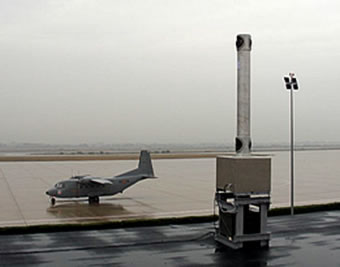 A new addition to perimeter defense systems is under development at Magna BSP, developers of a passive radar ‘Virtual Wall’ perimeter protection system, based on stereoscopic video motion detection system. The system is designed for unattended operation along a perimeter line or from a central location, protecting strategic facilities, border lines as well as airfields and harbors.
A new addition to perimeter defense systems is under development at Magna BSP, developers of a passive radar ‘Virtual Wall’ perimeter protection system, based on stereoscopic video motion detection system. The system is designed for unattended operation along a perimeter line or from a central location, protecting strategic facilities, border lines as well as airfields and harbors.
The sensor elements are comprised of two vertically-aligned IR micro bolometer cameras linked by the system’s processing module to provide accurate and reliable detection of targets, while passively determining the size and location of the target (in azimuth, distance and height above ground). The three-dimensional representation of the scenery provides accurate and reliable detection, with a high probability of detection (Pd), while maintaining a low false alarm rate (FAR). Magna’s patented algorithm, NFAR (Negligible False Alarm Rate), makes an accurate estimation even when targets are as small and far away as to fill a single pixel on the camera. As a result, system alerts are triggered only upon detection by both sensors. These systems filter false targets generated by new static objects, monotonic movements (wind etc.) targets are validated according to their movement parameters in the area of interest defined by the user.
Magna’s system include a range of static, panoramic sensor poles each carrying two (stereoscopic) or four (quadroscopic) sensors (two thermal IR and two CCD) covering a 360 degree zone, by staring sensors or scanning sensor poles. The sensors comprise an integrated IR/CCD camera which can operates in day and night, as well as under limited visibility conditions. The system’s displays warning signals superimposed over an aerial photo of the protected facility, in addition to the raw data of the panoramic view and images from the two sensors, used for identification, showing a close-up of the relevant sector, and indication of relevant moving targets.
 The Magna sensor maintains automatic target detection of a man size target at a range of up to 1.5 km providing full 3D stereoscopic image analysis including target size, velocity coordination, and ranging. The system has automatic and user defined filters, which eliminate false alarm by employing advanced algorithms, utilizing detection by multiple sensor the system has achieved remarkable levels of false target elimination. In fact, according to Magna BSP CEO, Haim Siboni, the company can an average false alarm rate of one per day, significantly lower than any competing system. Automatic identification of small objects also contributes to false alarm reduction, as targets detected at short range (such as birds flying through the sensor’s field of view). The system automatically filters monotonous movements but also indicates and alerts of new static objects that appearing in the surveillance sector.
The Magna sensor maintains automatic target detection of a man size target at a range of up to 1.5 km providing full 3D stereoscopic image analysis including target size, velocity coordination, and ranging. The system has automatic and user defined filters, which eliminate false alarm by employing advanced algorithms, utilizing detection by multiple sensor the system has achieved remarkable levels of false target elimination. In fact, according to Magna BSP CEO, Haim Siboni, the company can an average false alarm rate of one per day, significantly lower than any competing system. Automatic identification of small objects also contributes to false alarm reduction, as targets detected at short range (such as birds flying through the sensor’s field of view). The system automatically filters monotonous movements but also indicates and alerts of new static objects that appearing in the surveillance sector.
In 2006 the system was selected to provide perimeter protection for the Ben-Gurion Airport and is scheduled for fielding as perimeter protection for military facilities in Israel. In November 2006 the company announced that its systems were selected to protect French military facilities and mobile forces, following the evaluation conducted by Thales and the French defense technology agency. Based on the French requirements for up to 800 systems, total value of the program could reach up to €320 million over five years. At the initial phase, the company expects deliveries of 300 systems worth about €80 million. The company is also competing for a similar U.S. Marine Corps program. Magna BSP continued the development of the patented “virtual fens” and “Passive EO radar” technology in the past six years, backed by the founders and funding from the Israeli R&D. Among the recent applications explored by Magna are mobile applications, enabling manned and unattended partol vehicles inspect a border fense and detect tracks left by infiltrators, detection of irregular activity along the perimeter (such as planting IEDs) and detection of foreign objects (FOD) on runways at airports. In recent years the company also attracted investments form Israel MOD Defense Research & Development Directorate (DRDD) and private investors, including the Aeronautics Defense Systems group.

















